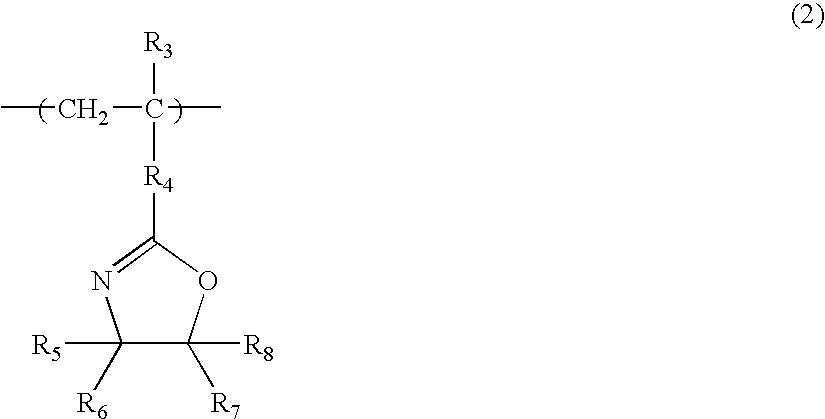Fiber-Reinforced Thermoplastic Resin Composition, Method for Producing the Same, and Carbon Fiber for Thermoplastic Resin
a thermoplastic resin and fiber-reinforced technology, which is applied in the direction of transportation and packaging, organic dyes, coatings, etc., can solve the problems of increasing the viscosity of the thermoplastic resin composition comprising reinforcing fibers, affecting the appearance affecting the strength of the molded product, etc., to achieve superior mechanical properties, good interface adhesion, and impact resistance.
- Summary
- Abstract
- Description
- Claims
- Application Information
AI Technical Summary
Benefits of technology
Problems solved by technology
Method used
Image
Examples
example 1
I. Step of Applying a Sizing Agent
[0253]A 5%-by-weight solution of A-1 (acrylic polymer) was prepared as a sizing agent and then applied to B-1 (carbon fiber) by a dipping method, followed by drying at 140° C. for 5 minutes. The amount of adhering A-1 (acrylic polymer) was 1.5 parts by weight with respect to 100 parts by weight of B-1 (carbon fiber).
[0254]B-1 (carbon fiber) to which the sizing agent had adhered in the above step 1 was cut to ¼ inch in size with a cartridge cutter.
III. Extrusion Step
[0255]A TEX-30α biaxial extruder (screw diameter: 30 mm, L / D=32) (the Japan Steel Works, LTD.) was used. C-1 (anhydrous maleic acid-modified polypropylene resin pellet) was supplied from the main hopper and B-1 (carbon fiber) that had been cut in the previous step was supplied from the side hopper downstream thereof. Then, sufficient kneading was carried out at a barrel temperature of 220° C. and at 150 rpm, followed by deaeration via a vacuum vent located further...
example 2
[0257]Example 2 was carried out in the same manner as Example 1, except that C-2 (mixture of native polypropylene resin and acid-modified polypropylene resin) was used instead of C-1 (anhydrous maleic acid-modified polypropylene resin pellet) in step III in Example 1. Table 1 shows evaluation results for the obtained molded product. The content of B-1 (carbon fiber) in the molded product was 20% by weight.
example 3
[0258]Example 3 was carried out in the same manner as Example 1 except that A-2 (acrylic polymer) was used instead of A-1 (acrylic polymer) in step 1 in Example 1. Table 1 shows evaluation results for the obtained molded product. The content of B-1 (carbon fiber) in the molded product was 20% by weight.
PUM
| Property | Measurement | Unit |
|---|---|---|
| mol % | aaaaa | aaaaa |
| number-average fiber length | aaaaa | aaaaa |
| acid value | aaaaa | aaaaa |
Abstract
Description
Claims
Application Information
 Login to View More
Login to View More - R&D
- Intellectual Property
- Life Sciences
- Materials
- Tech Scout
- Unparalleled Data Quality
- Higher Quality Content
- 60% Fewer Hallucinations
Browse by: Latest US Patents, China's latest patents, Technical Efficacy Thesaurus, Application Domain, Technology Topic, Popular Technical Reports.
© 2025 PatSnap. All rights reserved.Legal|Privacy policy|Modern Slavery Act Transparency Statement|Sitemap|About US| Contact US: help@patsnap.com



